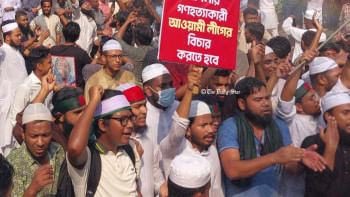Escaping poverty traps
POVERTY estimates, whether levels or trends, have a tendency to be deceptive. When a country witnesses a reduction in overall poverty levels between two periods, it is considered a win; but when pitted against a figure of 25% of the population continuously below the poverty line, the same statistic loses its meaning.
Those who cannot escape poverty are called the "chronic poor" -- destined to live in poverty and die in poverty. Until recently, little attention has been paid to this segment of the poor population, as it has been wrongly assumed that the poor are a homogenous group and a one-fits-all policy will serve the means of eradicating poverty. In fact, the main criticism against NGO activities in Bangladesh was that they hardly target the ultra and chronic poor. Of late however, Brac and certain other NGOs have begun to recognise those that have continually been marginalised -- the chronic poor.
Facts and faces
The Chronic Poverty Research Center (CPRC), a Manchester-based organisation, recently released their 2008-2009 report and made the findings public in collaboration with Brac Development Institute (BDI) and other stakeholders in Dhaka. Their research shows that, over the last five years and in an era of unprecedented global wealth creation, the percentage of chronic poor has increased.
According to the report, 320 to 443 million people are now "trapped" in a poverty that lasts many years, if not for their entire lifetime. For rural Bangladesh, Mahabub Hossain and I estimated that 30% of the households remain chronically poor. Earlier, Binayek Sen (World Bank) and David Hulme (Manchester University) also observed a ratio close to ours. That means about 39 million people in rural Bangladesh -- roughly one-third of our population -- have no escape from the jaws of poverty; despite funding from public, private and NGO sectors, the chronic poor continue to be born into poverty and die in poverty. We shall highlight some of the issues from the report in this article.
The poverty traps
The report identifies five main traps that underpin chronic poverty. First comes insecurity from environments and fewer assets to deal with shocks and stresses. They trade long-term goals to improve their lives (e.g. accumulating assets or educating children) for short-term survival. Second stands limited citizenship, as they have no meaningful political voice or effective political representation. They are effectually aliens in their own land. Third, spatial disadvantage such as remoteness from market, certain types of natural resource base and lack of economic integration could trap households in poverty. For instance, in urban areas, chances of chronic poverty may be higher in Hazaribagh than in Kalabagan areas of Dhaka city. Fourth comes social exclusion, based on class and caste systems, gender, religious and ethnic identity, age and other factors. Fifth, chronic poverty is high in areas with limited economic growth, or where growth is concentrated in enclaves, where people can be exploited. Such works allow day-to-day survival but does not permit accumulation of assets or the education of children, thus breeding a new generation of the chronic poor.
Policy responses
The report identifies five key policy responses to these five traps, creating an integrated policy set that can attack the multiple and overlapping causes of chronic poverty. Among these there are two policy areas -- social protection and public services -- that can spearhead the assault on chronic poverty. Social protection, particularly social assistance has a crucial role to play in reducing chronic poverty.
It tackles insecurity traps by protecting the poor from shocks and reducing their extreme vulnerability, helping them to conserve and accumulate assets so that they can improve their livelihoods and productivity. It also contributes to transforming socio-economic relations in ways that strengthen the long-term prospects of livelihood for the poor and chronic poor.
In this case, public provisions are vitally important because: (a) traditional forms of social protection are weakening; (b) new sources of social protection (such as remittances) rarely trickle down to the ultra poor; (c) private insurance markets are virtually non-existent in areas with a concentration of chronic poor. There is now a wealth of evidence supporting the fact that social protection is a cost-effective means of reducing poverty and chronic poverty, which can be scaled up even in relatively poor countries.
Agricultural growth has the potential to lift this population out of chronic poverty, but only if it is backed by three pillars: (a) development of transport infrastructure making local markets "thick" so that local cartels of landlords, traders, and employers can no longer impose their prices on factor and product markets; (b) increasing access to education so as to enhance productivity, mobility and malleability across occupations; and (c) increasing access to information for the poor in job opportunities, changes in input and output prices, new techniques and technologies and other such related issues.
Doable with determination
Eradicating chronic poverty by 2025 is a feasible goal but dependent upon political commitments from global governments, international organizations, and proper resource availability and allocation. Five policies rank high on the agenda: social protection, public services, individual and collective assets, de-marginaliszation, and strategic urbanisation and migration. The latter policy perhaps requires more explanation -- in this case, strategic urbanisation is not the growth of urban areas but linking urban areas with high growth potential rural areas, development of cities and towns in rural areas.
But let us not forget that the identification of the problems of the chronic poor and the pathways out of poverty would be country specific. For example, Bangladesh owes much of its reduction of infant mortality to NGOs and their campaigns, though in other countries the same outcome resulted from strong local governance and accountability. Likewise, chronic poverty must be addressed keeping socio-political economic contexts in mind. Success comes not simply from solutions, but from specific solutions for specific cases and contexts.

 For all latest news, follow The Daily Star's Google News channel.
For all latest news, follow The Daily Star's Google News channel. 



Comments